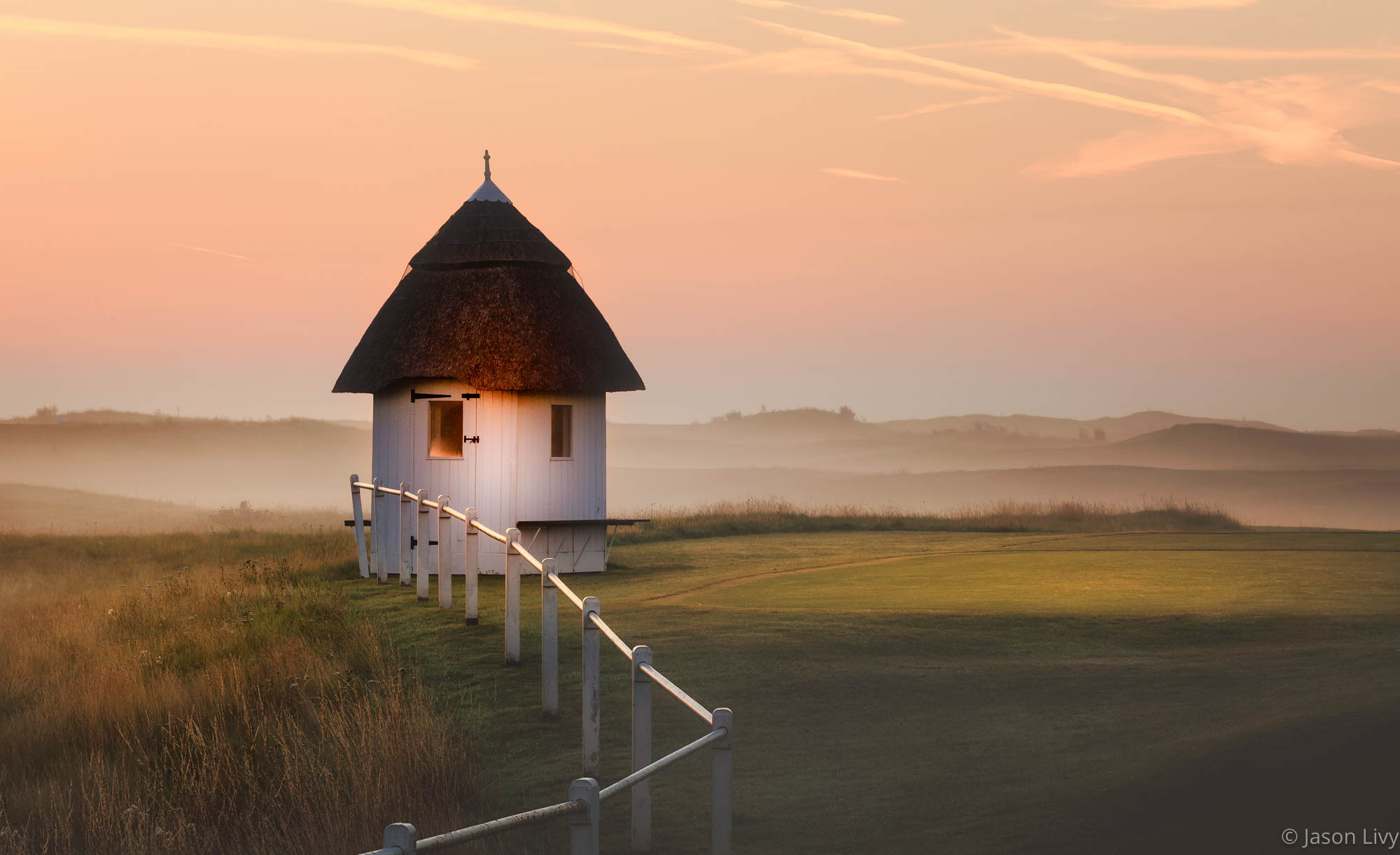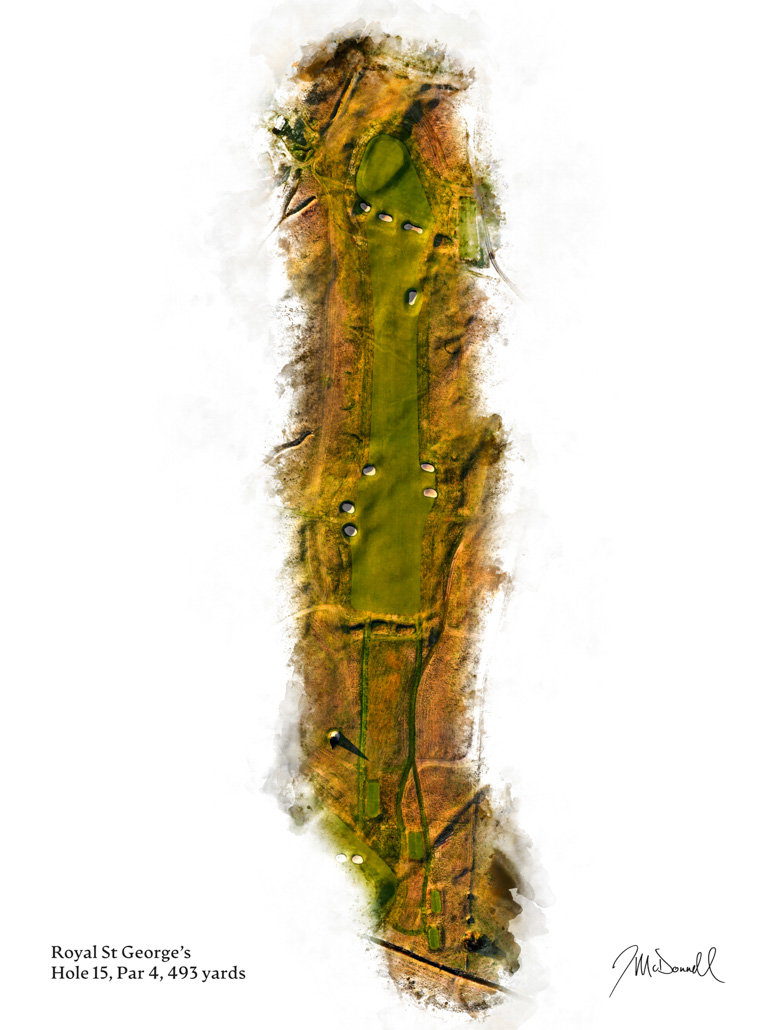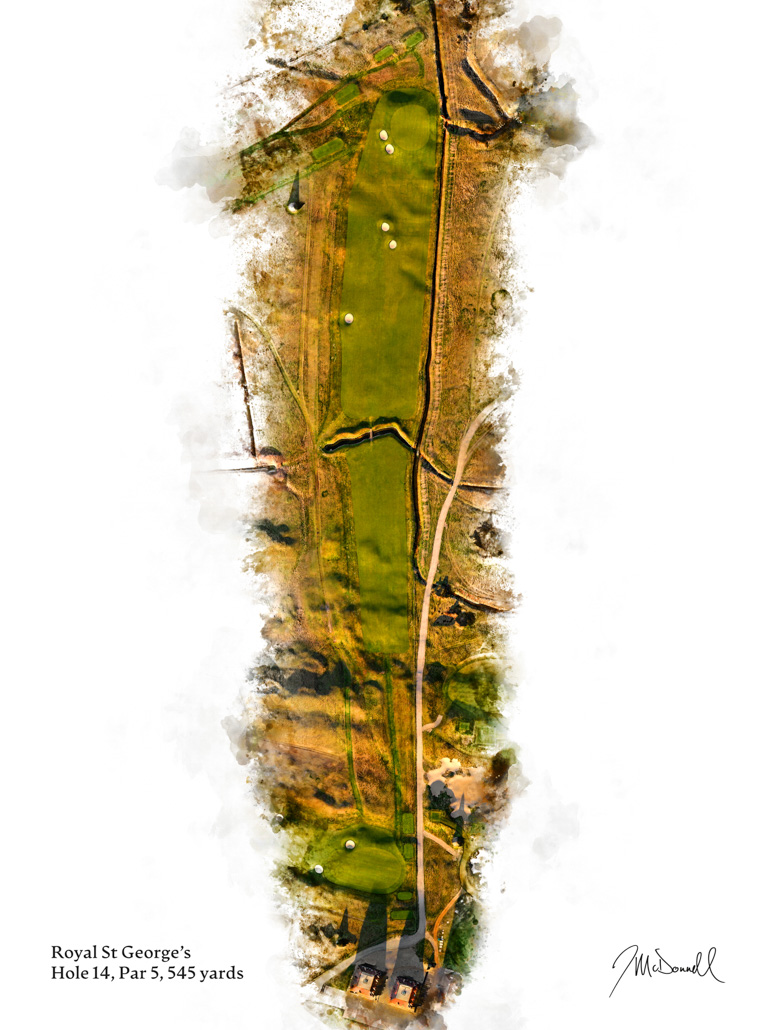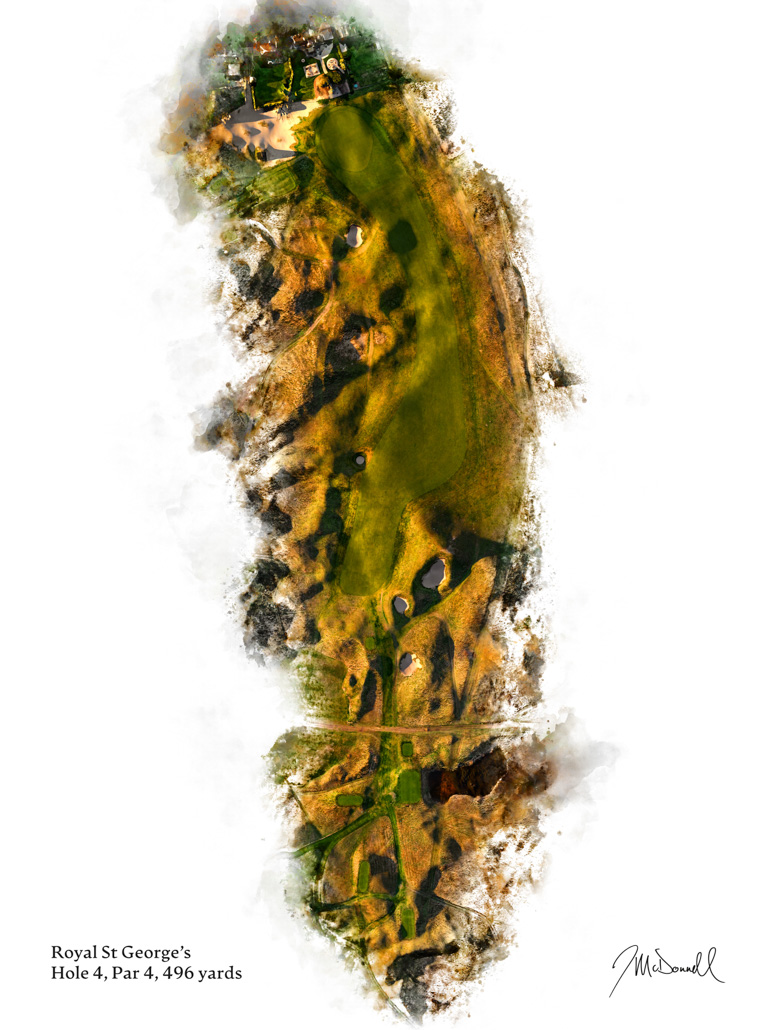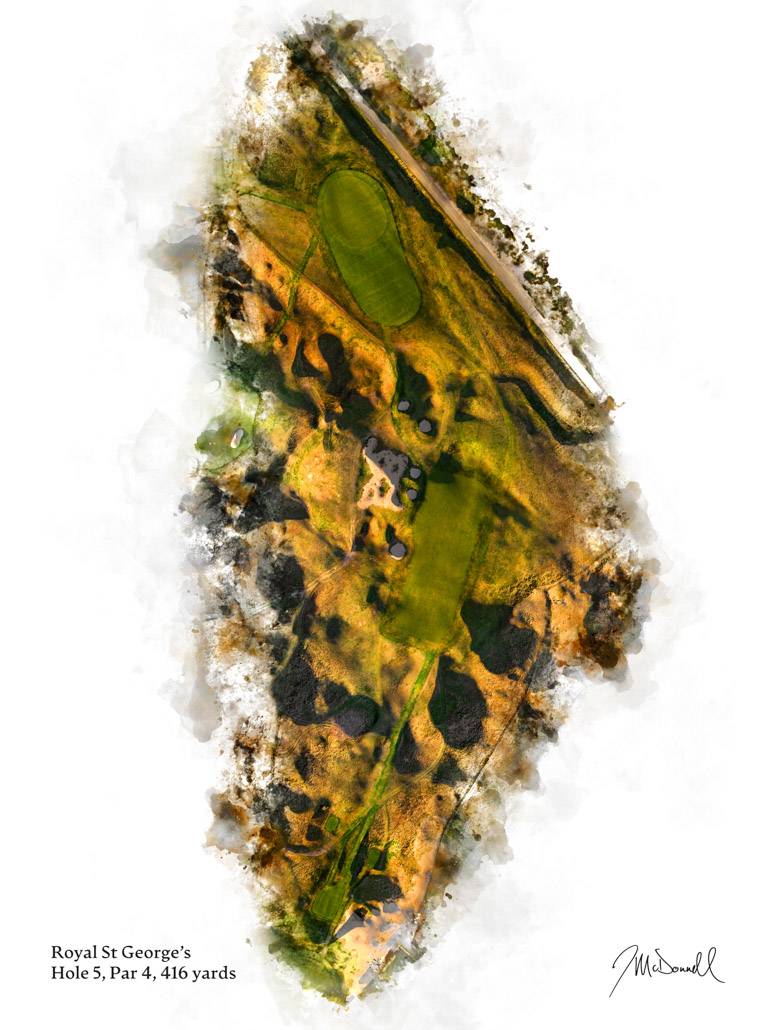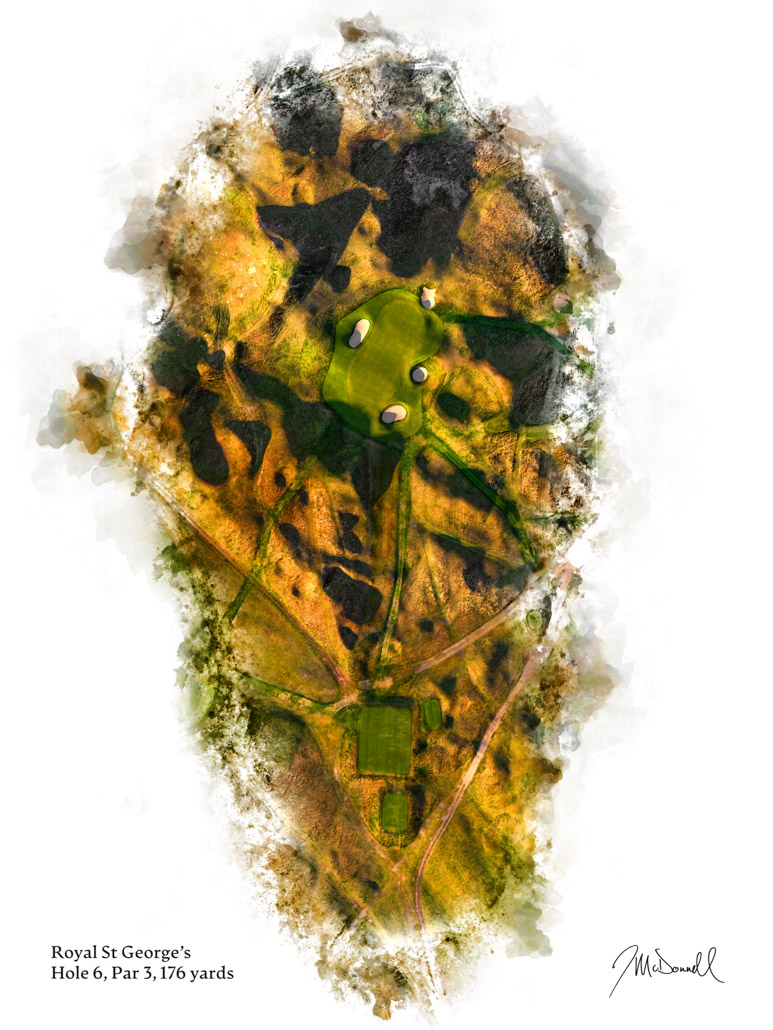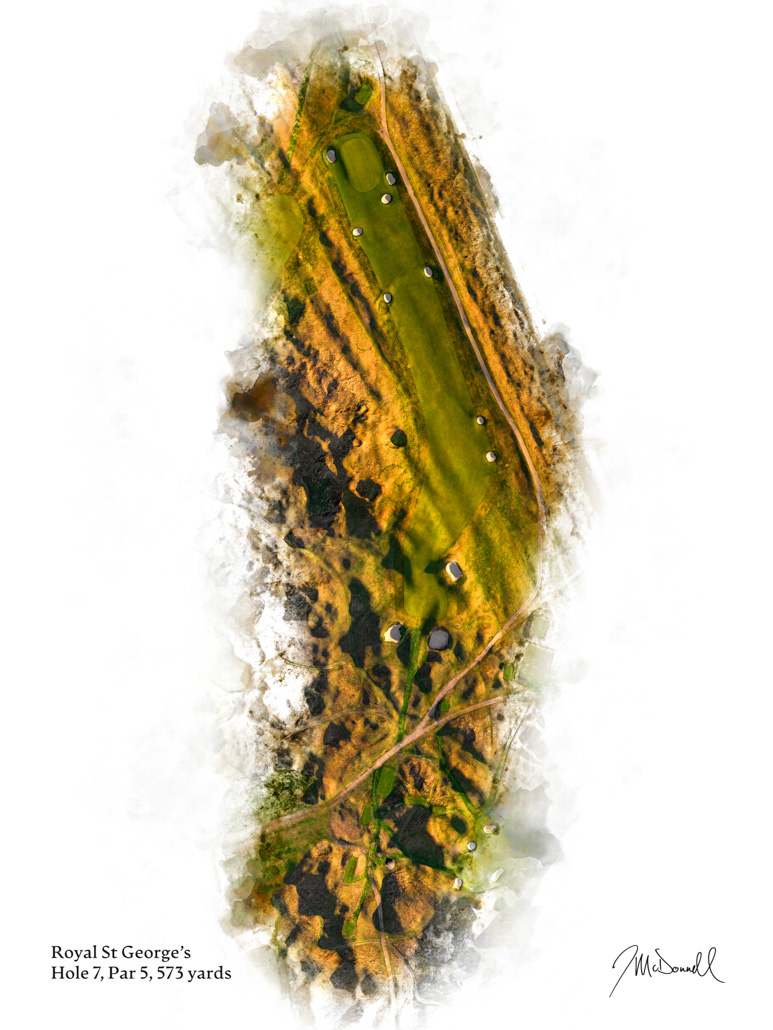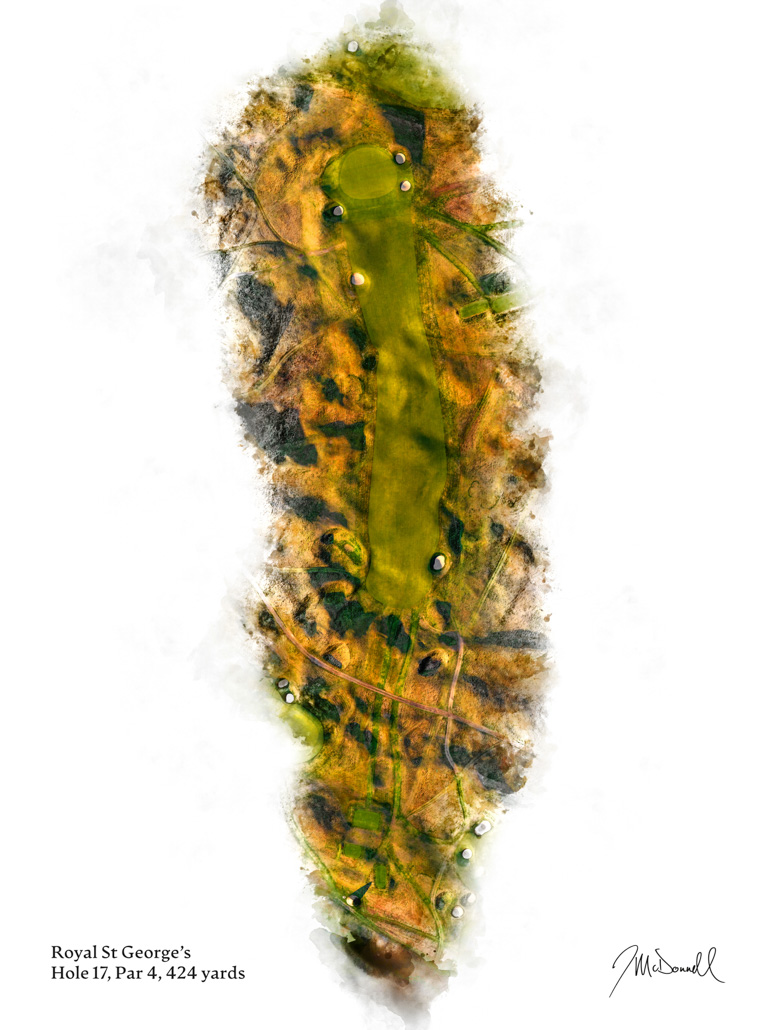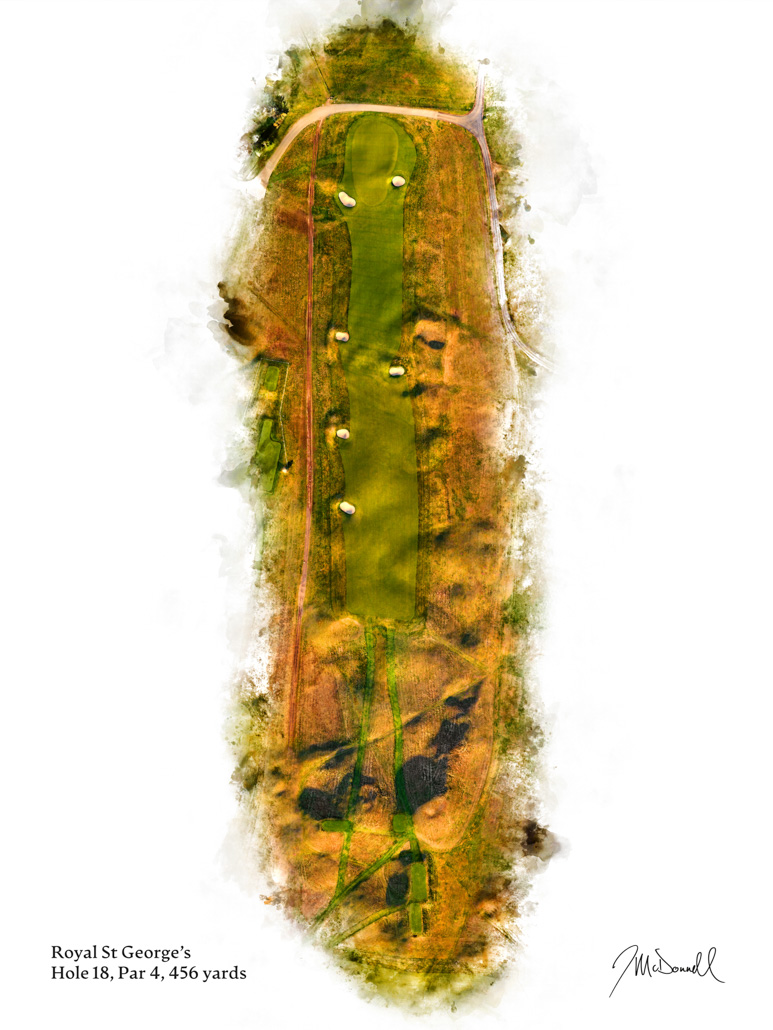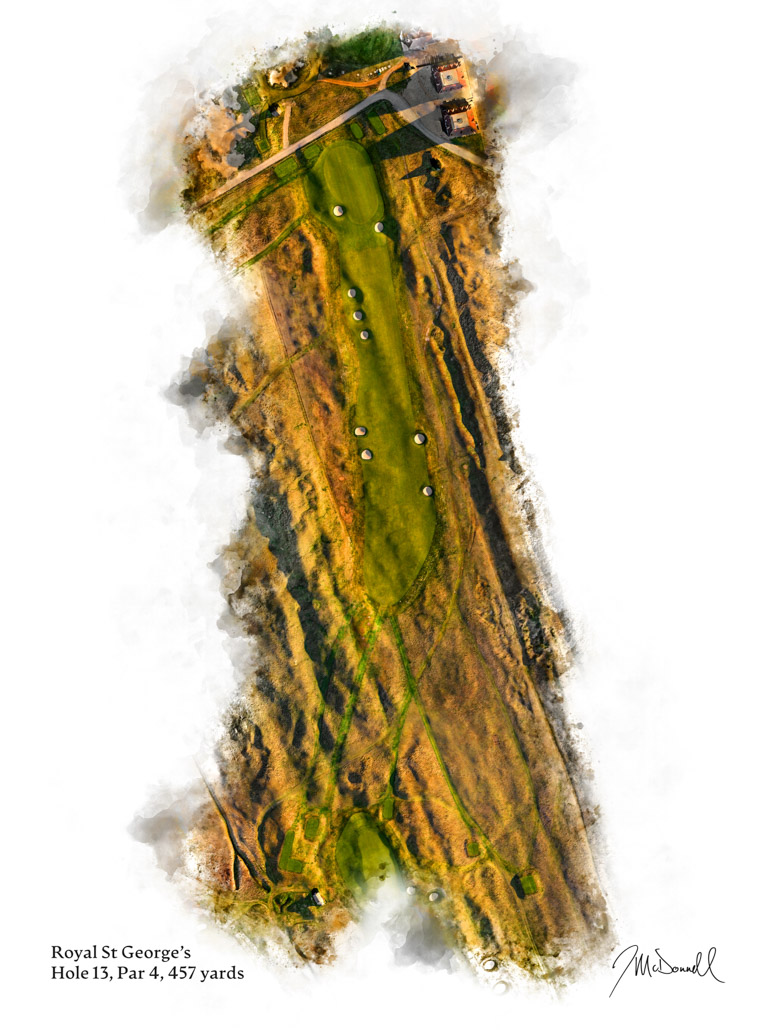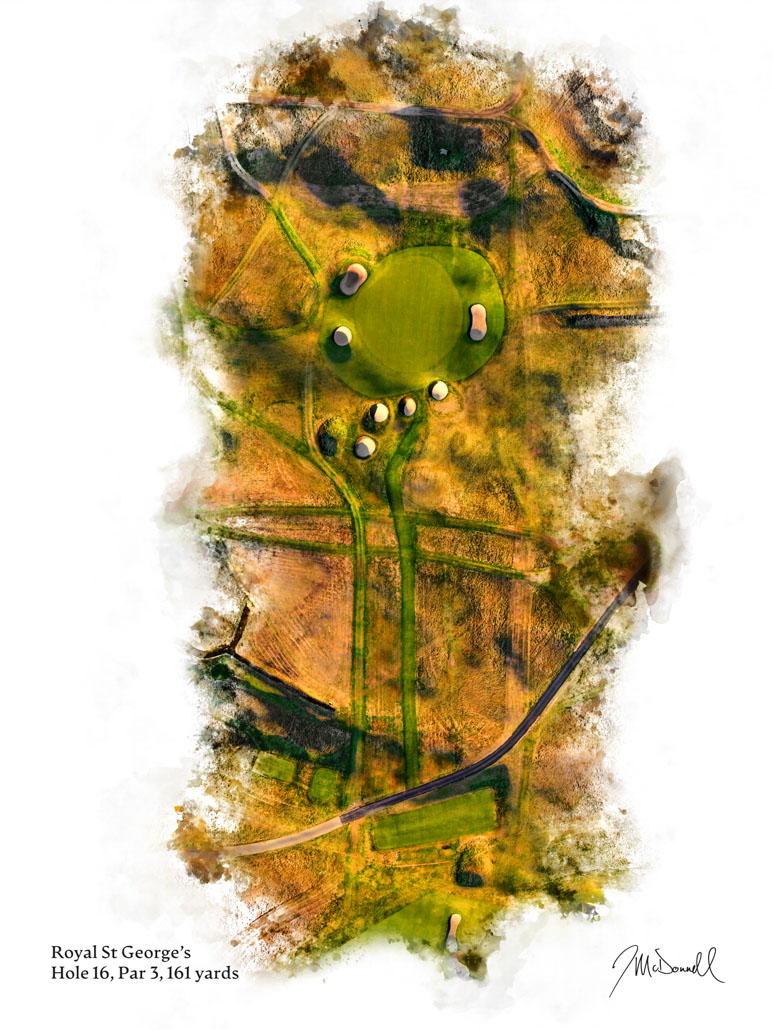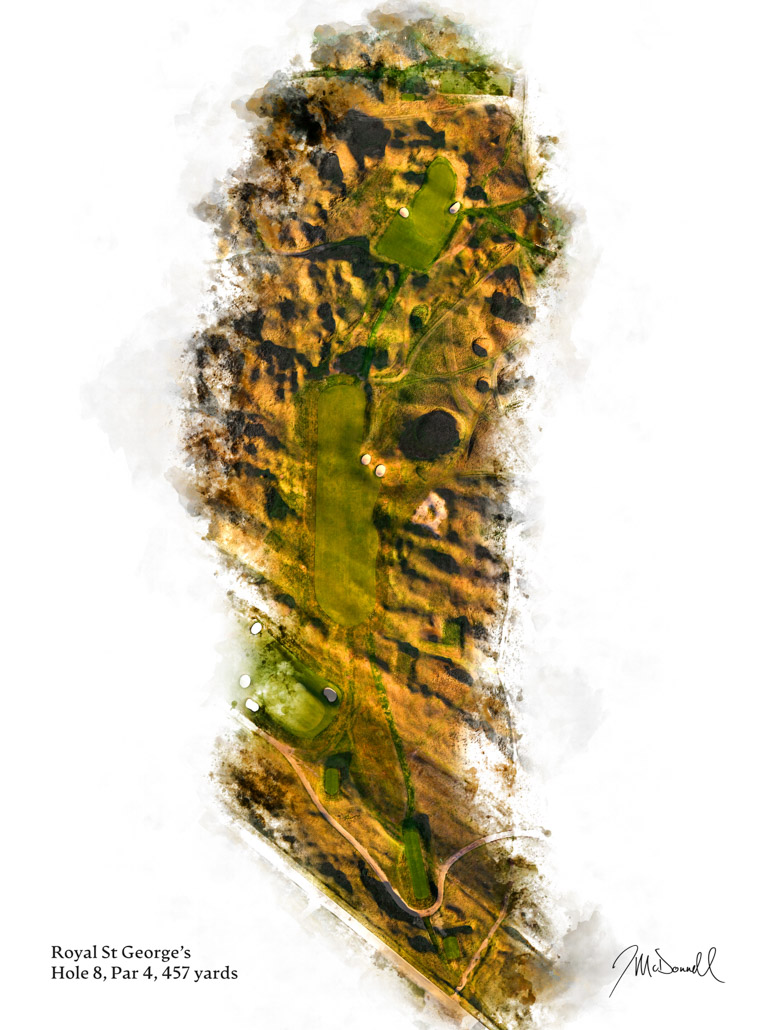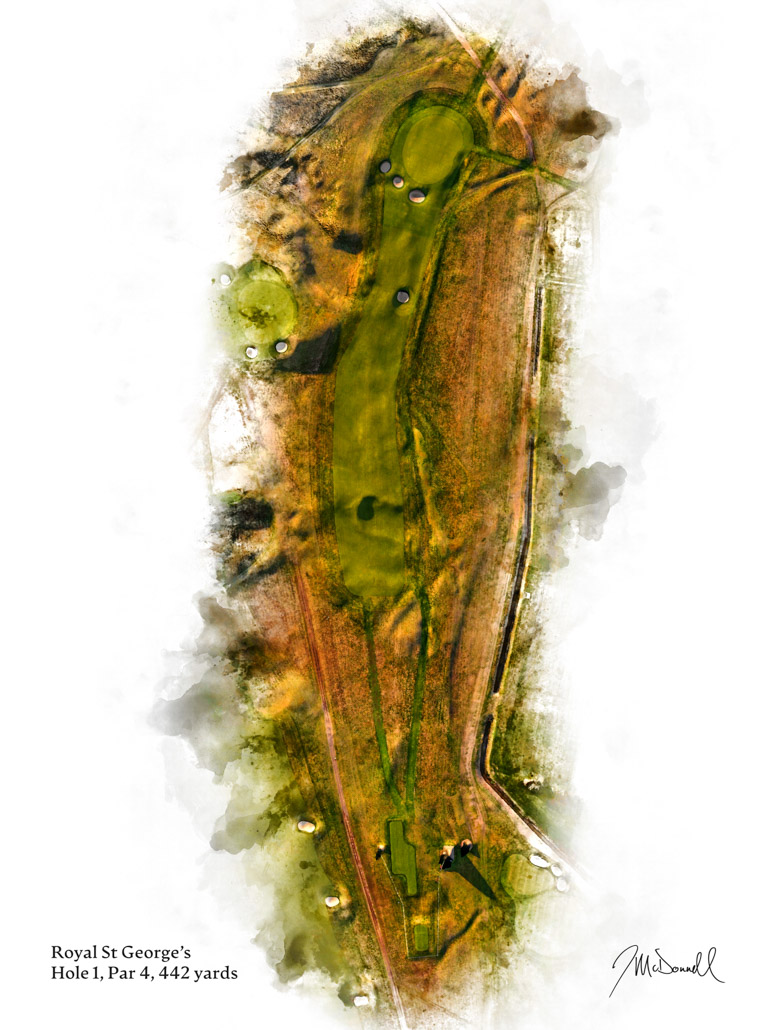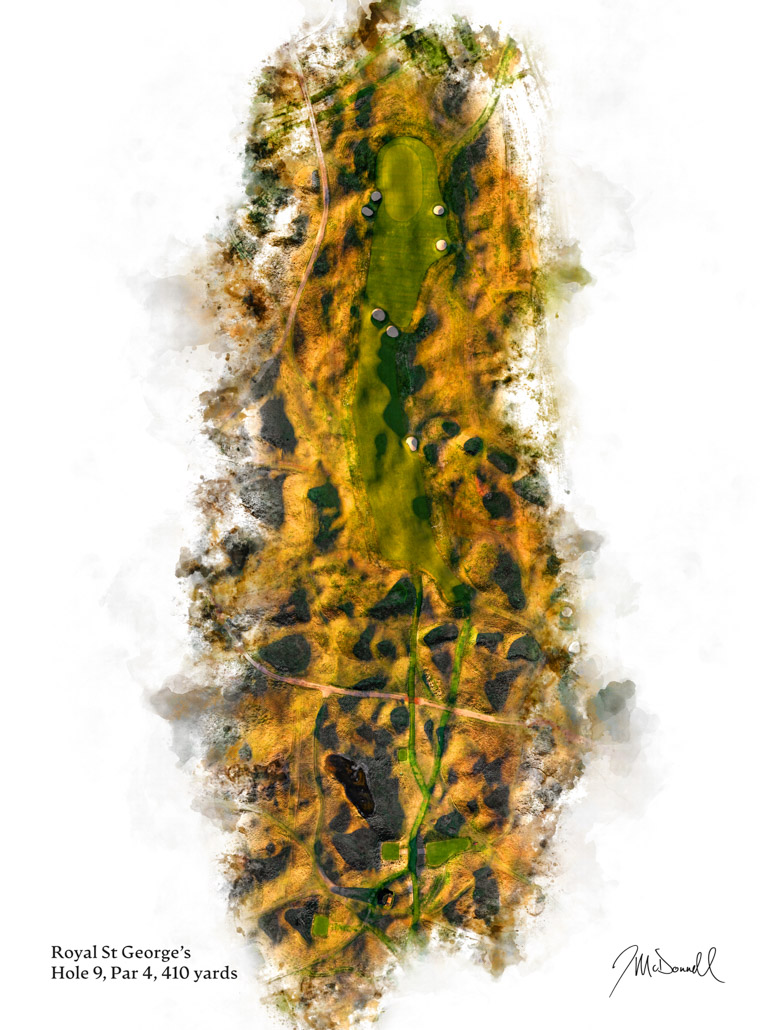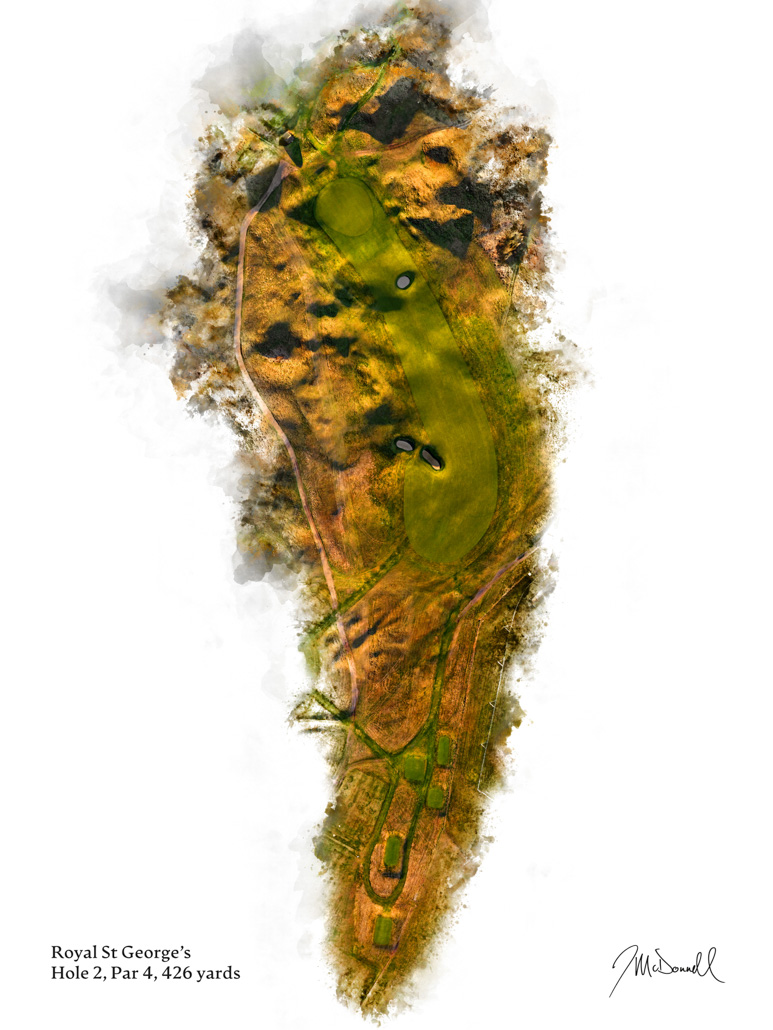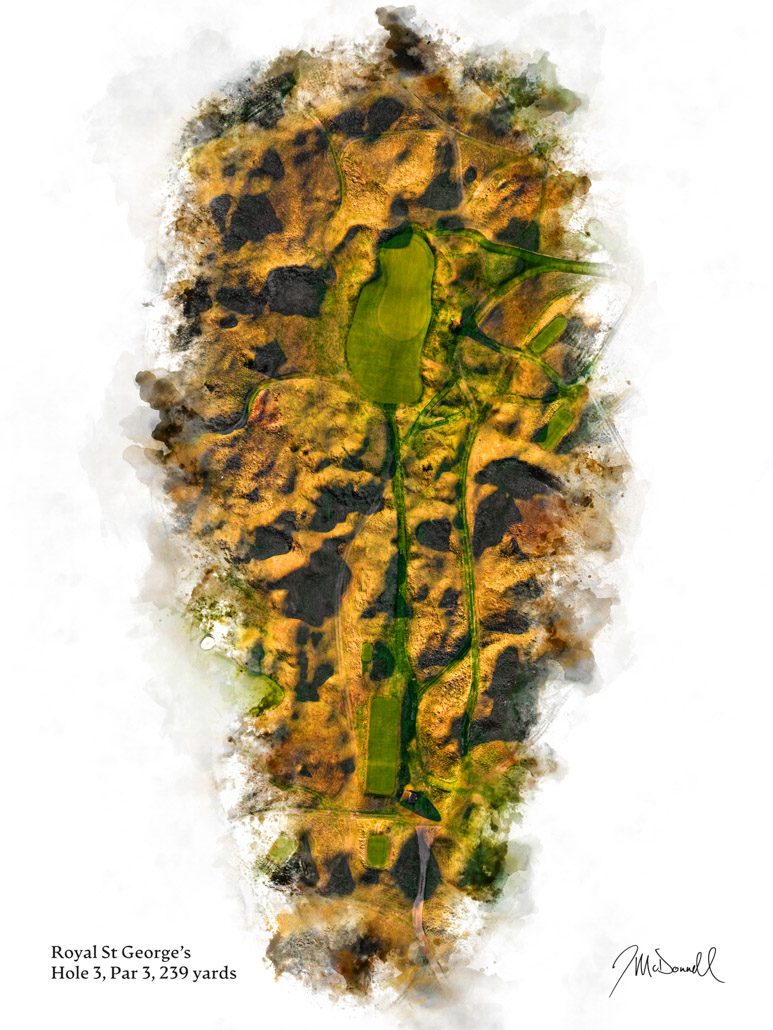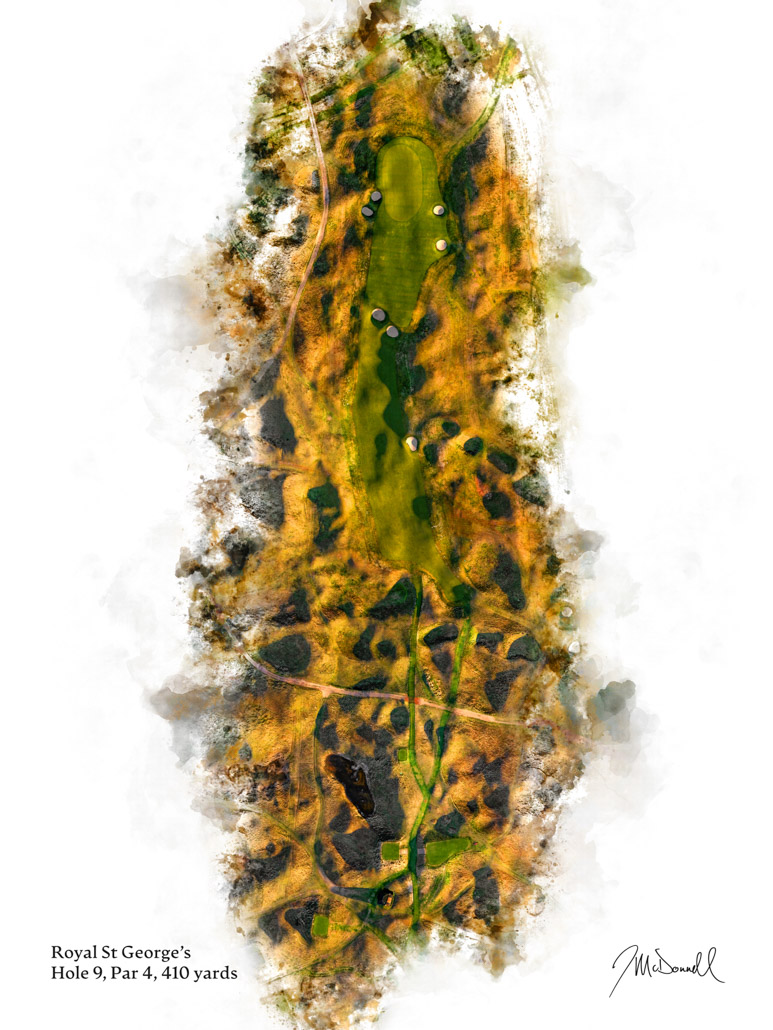Royal St George's Golf Club

Overview
St Georges was named as such as it was felt it could and would rival the Old Course which bore the name of Scotland's patron saint - St Andrew.
Bernard Darwin wrote: "When it was first discovered in 1887, it was acclaimed the greatest of all courses... Finer golfing country there never was: sandhills, bents, valleys, plateaus, hollows, undulations - it has them all."
Tom Doak recommends golf architecture students pay special attention to the routing. Routing is confounding with no two holes playing in the same direction. The parcel of land could easily fit another 18 holes and not feel cramped. Feelings of solitude prevail as one is playing the course wondering what 36 holes could be!
Tom Doak feels the 9th green has all the traits of an Alister MacKenzie design. The club is also home to the world-famous Sahara, Maiden, Himalayas, and Suez Canal.
Forced carries and target golf fairways. It is a driver's golf course and championship test.
Hallmark red artillery boxes are found on the teeing grounds & Bogey Score is rightly found on the scorecard.
Bordering Princes Golf Club to the North and Royal Cinque Ports Golf Club to the South, this in the running for the best stretch of links golf in the world.
Golf Course Review
William Laidlaw Purves, the founder, and creator of Royal St George's Golf Club is a name that doesn't resonate with golf course architecture aficionados. Born in Edinburgh, he was a member at Bruntsfield Links, Muirfield and the Royal & Ancient of St Andrews. After moving to London, he became a member at London Scottish GC and what would then become the Royal Wimbledon Golf Club. While Dr. WL Purves was the driving force in developing the club, Henry Lamb and William Anderson were also prominent founding members.
Royal St George's Golf Club History
Craving links golf, Purves set off to the Kentish coast in search of dunes land which would provide a blank canvas for a course to rival the best in Scotland. The land chosen at Sandwich Bay to become Royal St George's Golf Club was spied out from atop the St Clements Church in Sandwich. The club was established on May 23, 1887, and became a Royal Golf Club on May 17, 1902. King Edward VII conferred the royal title, was the club's first royal patron, and the royal club captain from 1927-28.
The dunes are wild and untamed unlike anything found at Muirfield or St Andrews. The course has become not a rival but rather a contemporary amongst the leading golf courses in the world. Only 7 years after the course had been built, in 1894, it hosted the first Open Championship outside of Scotland. Amazingly, sheep roamed the course until 1900. It will have hosted 15 Opens by 2021, becoming the Open's home away from home.
The Evolution of Sandwich
Some changes have been made to the course over time. The original holes at Royal St George's Golf Club are 1, 2, 4, 7, 12, 13, and 15. There have been three major evolutions of the course since its inception. 1888 to 1909, 1909 to 1980, and 1980 until the present.
It was the original (1887 - 1909) iteration of Royal St George's Golf Club that featured The Maiden and Sahara - and a plethora of blind shots. In 1893, it was said the holes ranged in distance from 150 yards to 500 yards, with the scorecard totaling 6,143 yards. The course record was a 78! It was noted that every tee shot needed to cross a hazard. Since then, the blind tee shots have been tamed or removed. Routing in and around the famous 6th hole - a blind par 3 called Maiden, has made up the lion's share of the work since its inception.
The major changes which were approved in 1907 added roughly 300 yards to the scorecard. By 1909, the alterations were approved, built, and in play. Said to make the course less fluky, they also reduced blindness and sped up play.
The most recent major change to Royal St George's Golf Club was made by Mr. Donald Steel who moved the 14th green closer to the burn and O.B. whilst simultaneously adding two bunkers on the centreline of the fairway.
Changes to Royal St George's for the 149th Open
On the front nine, perhaps the most demonstrable change from the last Open is the removal of the sleepers on the Himalayas on 4.
Subtle tweaks have also been made for The 149th Open by MacKenzie and Ebert. The 5th, 6th, 7th, 17th and 18th have all been subtly tweaked.
The bailout area left of the five-pot bunkers on the inside of the dogleg on 5 has been replaced by a waste area that has the potential to derail your round early and wreck a card.
The rear bunker on 6 is no longer a pot, but rather a blow-out.
The tee shot on 7 originally had three bunkers that needed to be carried off the tee. By 2008, all three had become grassed hollows. Two of the three have been reinstated which now provides a chute to aim through.
On the back nine, the rear bunker guarding the left side of 17 was a single bunker at the last Open in 2011. In the interim, it became two. Now, for the 149th Open, it has been removed completely. A grass collection area cut short has taken its place instead.
18 was known for three large bunkers bisecting the fairway. These existed until 2007 when the left bunker was removed completely leaving the middle and right. By 2018, the middle bunker was filled and the left reappeared. There are considerably smaller than originally and are now staggered, creating a needle's eye which needs to be threaded from the tee.
The St George's Experience vs The Championship Test
Royal St George's Golf Club needs to be experienced to be enjoyed. Predominantly a two-ball club, foursomes is the preferred game of choice. Four golfers, playing two balls in alternating sequence plot their way around the course in well under 3 hours in a morning match. Returning to the clubhouse for a legendary carvery and generous libations in jacket and tie is one of golf's most time-honored traditions. An afternoon match of foursomes is then swiftly enjoyed. Returning to the clubhouse, one makes use of the changing rooms and one of golf's best showers before post-round drinks and departing for home. The course itself is designed for match play. Foursomes paths crisscross the property allowing the matches to expedite play across the 300 acres with which Royal St Georges is routed. The enjoyment of the game itself is the lofty standard and ultimate goal of the Royal St George's experience.*
Card and pencil golf is not the aspiration at Royal St George's Golf Club... outside of the Open. This is probably why so many have been so vocal about its merits as an Open venue. Jack Nicklaus, Gary Player, Tom Watson all are less than positive about it - even questioning its place in the rota. Whilst some of the world's best may doubt its place in the Open rota, the Opens held at Royal St George's Golf Club are crowd-pleasers that rarely disappoint. Watching the world’s best battle each other, the elements, themselves and the course create theatre which is rarely rivaled.
Polarising for players, Royal St George's Golf Club is virtually universally applauded by spectators. Recent winners include Darren Clarke, Greg Norman, Ben Curtis, and Sandy Lyle. Prior to WW2, Henry Cotton, Walter Hagen, Harry Vardon, Jack White, and J.H. Taylor were all crowned as the champion golfer of the year. This is also the site of another Dustin Johnson miscue and another Major that slipped away...
*For the full golfing experience, spend the extra for a caddy for your tee time. With a caddy, you will be able to try some of the Championship Tee's (for example, 4 and 5) and alternative tee's reserved for the Open (for example, 13).
The first time around Royal St George's Golf Club can also be confusing. An experienced guide will lighten the load, lead the way, highlight course changes and show you where some of the most iconic moments of the Open took place. (Tom Watson's hole in one on 6 & The Thomas Bjorn Affair on 16 in one of Royal St George's deepest bunkers!)
Architectural Hallmarks of Royal St George's Golf Club
Forced Carries from the Tee:
Arguably every tee shot at Royal St George's Golf Club is a forced carry-over dunes or whins. Whilst most handy golfers playing from appropriate tees won't be overwhelmed, even the best players in the world will need to be on their game when playing from the back tees. Weighing in at just over 7,200 yards, some of the carries will test even the longest hitters especially if the wind begins to howl.
Island Fairways & Target Golf:
5, 8, and 14 have island fairways. Characteristic of Pine Valley and a hallmark of George C Thomas, target golf from the tee adds another layer of difficulty. 18 originally had 3 bunkers which created a break and line of defense between two island fairways on the final hole.
Due to the exuberant nature of the fairways, there are landing zones that need to be sought after even at the expense of distance. For example, a shorter club will be taken off the first tee to find 'The Kitchen' and in particular 'The Sink' - a somewhat level area on the left-hand side of the fairway from where the attack of the green is easier despite a longer club in hand.
Another example is 'The Tennis Court' on 9 which provides a similar advantage.
There are also Turbo Boosts that can be found. A drive that finds the downslope on 7 can add significant yardage to the shot.
Use of and Routing Through Dunes:
Some courses are blessed with impressive dunes. Take Trump Scotland as a fine example. Hitting off elevated teeing grounds into stadium-like valleys, the experience is exhilarating and used to good effect. It can, however, become familiar especially with a prevailing wind in an out and back routing. Sandwich though is different. The first 2 holes wind their way into the dunes.
The 3rd, a bunker-less par 3, plays in the valley and in the shadows of some of the largest dunes in all of golf.
The 4th plays over or around a dune and halfway up the back of another at the green. The 5th begins atop a dune into a valley and through the sliver of space where the dunes intersect. The 6th plays back in and the 7th up and out. The routing runs up, over, through, parallel with and perpendicular to the ranges of dunes in a thrill ride that would never get old.
Monumental Movement in Fairways:
The movement in Royal St George's Golf Club's fairways ebbs and flows. There are portions of fairways that offer respite, especially on the back nine. However, the rambunctious nature of the fairways creates bounces and caroms which add a layer of uncertainty, unfairness, and providence which usually will even out. For those who make a living playing the game, it can and does drive them mad. For those who are here for the experience, forget the score and focus on the match. Embrace it and grab hold of the challenge it presents.
Royal St George's GC Synopsis
Royal St George's Golf Club is a colossus in the game of golf as one of the world's finest links. In a rare twist, the game being showcased on the world's biggest stage is made even better by foursomes play.
Royal St George's is more than just a round of golf. Royal St George's Golf Club is an experience, one that must be savored, absorbed, and then treasured.
Royal St George's Golf Club & The Open
Royal St George's Golf Club, or Sandwich, is The Open's home away from home. The club has hosted the tournament 14 times. No other course has hosted The Open more than Sandwich outside of Scotland. It is the Open's course in England.
The 34th Open Championship in 1894 was the first Open to be played outside Scotland and the first to feature the Great Triumvirate - JH Taylor, Harry Vardon, and James Braid.
- Colin Morikawa won The 149th Open in 2021
- Darren Clarke won The 140th Open in 2011
- Ben Curtis won The 132nd Open in 2003
- Greg Norman won The 122nd Open in 1993
- Sandy Lyle won The 114th Open in 1985
- Bill Rogers won The 110th Open in 1981
- Bobby Locke won The 78th Open in 1949
- Reg Whitcombe won The 73rd Open in 1938
- Henry Cotton won The 69th Open in 1934
- Walter Hagen won The 63rd Open in 1928
- Walter Hagen won The 57th Open in 1922
- Harry Vardon won The 51st Open in 1911
- Jack White won The 44th Open in 1904
- Harry Vardon won The 39th Open in 1899
- JH Taylor won The 34th Open in 1894.
The golf is world-class but the practice facilities are not. A temporary driving range is established for The Open. A refined and elegant pro shop on-site stocks items with the familiar red St George logo.
Independent Reviews of Royal St George's Golf Club
Read Golf Club Atlas' review of Royal St George's Golf Club.
Fancy the Royal St George's Golf Club Artwork?
Purchase the featured Royal St George's Golf Club artwork.


Royal St George's Golf Club - Videos
Click Here to Watch the Links From The Road Epic
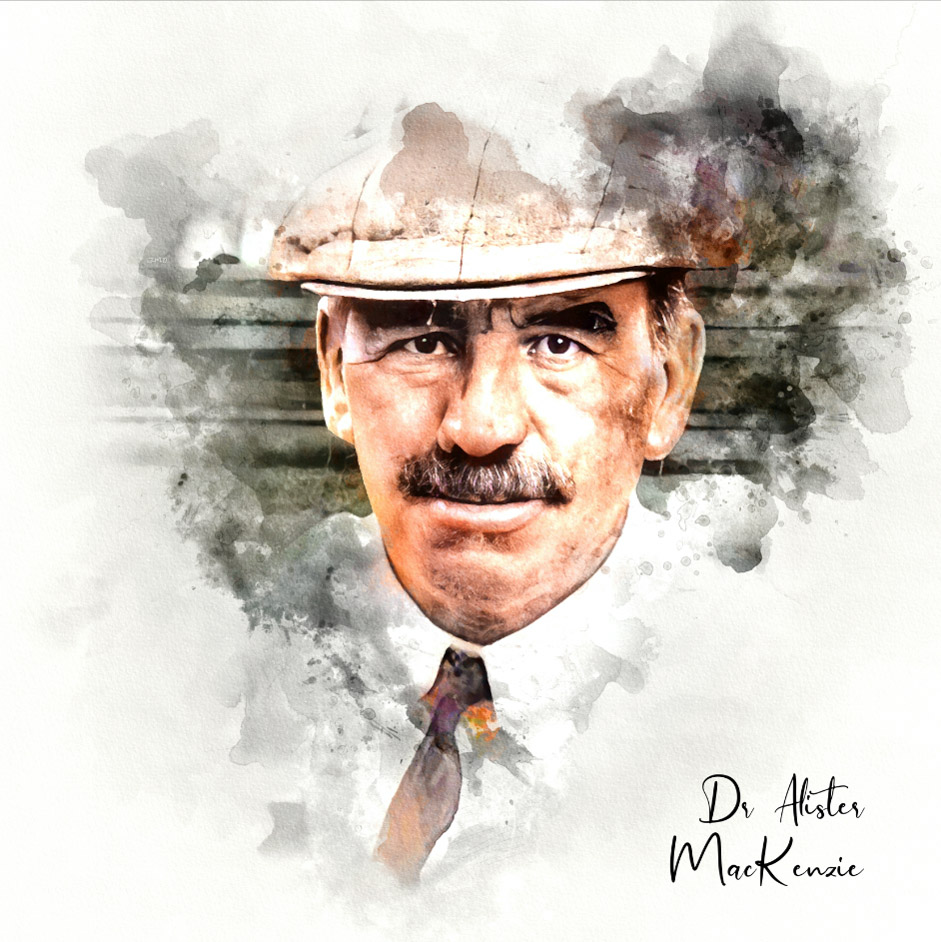
Featured Architect: MacKenzie, Alister
As taken from his book, Golf Architecture, Alister MacKenzie felt the following were essential: The course, where possible, should be arranged in two loops of nine holes. There should be a large proportion of good two-shot holes and at least four one-shot holes. There should be little walking between...

